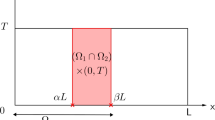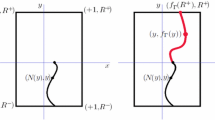Abstract
In this paper, we are concerned with a non-overlapping domain decomposition method for solving the low-frequency time-harmonic Maxwell’s equations in unbounded domains. This method can be viewed as a coupling of finite elements and boundary elements in unbounded domains, which are decomposed into two subdomains with a spherical artificial boundary. We first introduce a discretization for the coupled variational problem by combining Nédélec edge elements of the lowest order and curvilinear elements. Then we design a D-N alternating method for solving the discrete problem. In the method, one needs only to solve the finite element problem (in a bounded domain) and calculate some boundary integrations, instead of solving a boundary integral equation. It will be shown that such iterative algorithm converges with a rate independent of the mesh size.
Similar content being viewed by others
References
Adams, R.: Sobolev Spaces. Academic, New York (1975)
Alonso, A., Valli, A.: Some remarks on the characterization of the space of tangential traces of H(curl, Ω) and the construction of an extension operator. Manuscripta Math. 89, 159–178 (1996)
Alonso, A., Valli, A.: An optimal domain decomposition preconditioner for low-frequency time-harmonic Maxwell equations. Math. Comp. 68, 607–631 (1999)
Bendali, A.: Numerical analysis of the exterior boundary value problem for the time-harmonic Maxwell equations by a boundary finite element method. Part 1: the continuous problem. Part 2: the discrete problem. Math. Comp. 43(167), 29–46 and 47–68 (1984)
Buffa, A., Costabel, M., Sheen, D.: On traces for H(curl, Ω) in Lipshitz domains. J. Math. Anal. Appl. 276(2), 845–876 (2002)
Buffa, A., Hiptmair, R.: Galerkin boundary element methods for electromagnetic scattering, on “computational methods in wave propagation.” In: Ainsworth, M. et al. (eds.) Lecture Notes in Computational Science and Engineering, vol. 31, pp. 83–124. Springer, Berlin Heidelberg New York (2003)
Buffa, A., Hiptmair, R., Von Petersdorff, T., Schwab, C.: Boundary element methods for Maxwell equations on Lipschitz domains. Numer. Math. (2002)
Cessenat, M.: Mathematical methods in electromagnetism. In: Advances in Mathematics for Applied Sciences, vol. 41. World Scientific, Singapore (1996)
Colton, D., Kress, R.: Inverse acoustic and electromagnetic scattering theory. In: Applied Mathematical Sciences (2nd edn), vol. 93. Springer, Berlin Heidelberg New York (1998)
Dubois, F.: Discrete vector potential representation of a divergence free vector field in three dimensional domains: numerical analysis of a model problem. SIAM J. Numer. Anal. 27, 1103–1142 (1990)
Girault, V., Raviart, P.: Finite Element Methods for Navier–Stokes Equations. Springer, Berlin Heidelberg New York (1986)
Hu, Q., Yu, De-hao: Solving singularity problems in unbounded domains by compling of natural BEM and composite grid FEM. Appl. Numer. Math. 37, 127–143 (2001)
Hu, Q., Yu, De-hao: A solution method for a certain nonlinear interface problem in unbounded domains. Computing 67, 119–140 (2001)
Hu, Q., Zou, J.: A non-overlapping domain decomposition method for Maxwell’s equations in three dimensions. SIAM J. Numer. Anal. 41, 1682–1708 (2003)
Hu, Q., Zou, J.: Substructuring preconditioners for saddle-point problems arising from Maxwell’s equations in three dimensions. Math. Comp. 73, 35–61 (2004)
Ja, Zu-peng, Wu, Ji-ming, Yu, De-hao: The coupled natural boundary-finite element method for solving 3-D exterior Helmholtz problem. Math. Numer. Sin. 23(3), 357–368 (2001)
Kuhn, M., Steinbach, O.: FEM-BEM coupling for 3d exterior magnetic field problems. In: Neittaanmäki, P., Tiihonen, T., Tarvainen, P. (eds.) ENUMATH 99 - Proceedings of the 3rd European Conference on Numerical Mathematics and Advanced Applications, Jyväskylä, Finland, 26–30 July 1999. pp. 180–187. World Scientific, Singapore (2000)
Lenoir, M.: Optimal isoparametric finite elements and error estimates for domains involving curved boundaries. SIAM J. Numer. Anal. 23, 562–580 (1986)
Lebedev, N.N.: Special Functions and Their Applications. Dover, New York (1972)
Liu, Shi-shi, Liu, Shi-da: Special Function. Weather Press, Beijing, China (1988)
Monk, P.: Finite Element Methods for Maxwell’s Equations. Clarendon, Oxford (2003)
Nédélec, J.C.: Mixed finite elements in R 3. Numer. Math. 35, 315–341 (1980)
Nédélec, J.C.: Acoustic and Electromagnetic Equations: Integral Representations for Harmonic Problems. Springer, Berlin Heidelberg New York (2001)
Quarteroni, A., Valli, A.: Numerical Approximation of Partial Differential Equations. Springer, Berlin Heidelberg New York (1994)
Toselli, A., Widlund, O., Wohlmuth, B.: An iterative substructuring method for Maxwell’s equations in two dimensions. Math. Comp. 70, 935–949 (2001)
Yu, De-hao: Mathematical Theory of Natural Boundary Element Method. Science Press, Beijing, China (1993)
Yu, De-hao: A domain decomposition method based on natural boundary reduction over unbounded domain. Math. Numer. Sin. 16(4), 448–459 (1994)
Yu, De-hao, Xue, Wei-Min, Huang, Hong-ci: A Dirichlet–Neumann alternating method in infinite domain: algorithm and convergence analysis. Research Report, ICM-95-31, Chinese Academy of Sciences; Technical Report, Math-092, Department of Mathematics, Hong Kong Baptist University (1995)
Yu, De-hao: Natural Boundary Integral Method and Its Applications. Kluwer, Boston, MA (2002)
Author information
Authors and Affiliations
Corresponding author
Additional information
Communicated by: Y. Xu.
This work of Yang Liu and Dehao Yu was subsidized by the National Basic Research Program of China under the grant G19990328,2005CB321701, and the National Natural Science Foundation of China under the grant 10531080.
The work of Qiya Hu was supported by Natural Science Foundation of China G10371129.
Rights and permissions
About this article
Cite this article
Liu, Y., Hu, Q. & Yu, D. A non-overlapping domain decomposition for low-frequency time-harmonic Maxwell’s equations in unbounded domains. Adv Comput Math 28, 355–382 (2008). https://doi.org/10.1007/s10444-007-9027-6
Received:
Accepted:
Published:
Issue Date:
DOI: https://doi.org/10.1007/s10444-007-9027-6
Keywords
- Maxwell’s equations
- Unbounded domains
- Domain decomposition
- Boundary integral
- Nédélec finite elements
- D-N alternation




